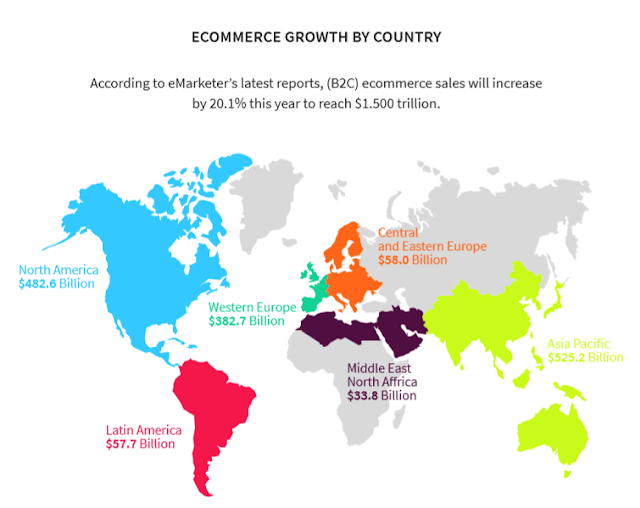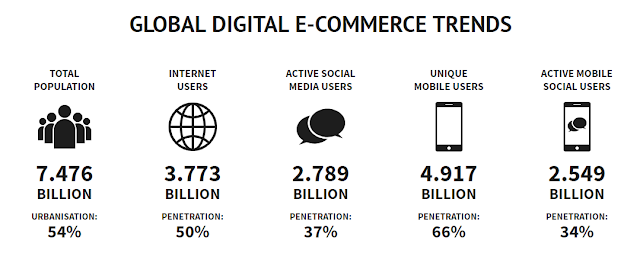The global eCommerce market has demonstrated explosive growth in the past couple of years and its future is expected to be booming. In 2017, the global e-retail sales amounted to 2.3 trillion U.S. dollars and projections show a growth of up to 4.48 trillion U.S. dollars by 2021. This astonishing growth is primarily being driven by consumers using their mobile devices to acquire goods and services. In this ultra-competitive environment, finding and acquiring new customers can be a huge challenge for merchants. In addition, 53% of adults living in high-income households claim to be willing to switch brands for the sake of using a coupon.
The challenges for players in this giant market are key, including customer loyalty, achieving profitable long-term growth, and choosing the right technology and partners, among others. At the same time, the tremendous evolution of blockchain technology is radically changing the way many markets operate. Important USPs of blockchain like transparency, coherence, cost-effectiveness and effective integration with processes at all levels of the business can bring to the e-commerce market endless opportunities. Now, imagine the explosive combination of e-commerce, blockchain technology, and cryptocurrencies: the IOU Platform, a true P2P e-commerce loyalty platform on the blockchain.
The e-commerce market is a global giant. For private consumers around the globe, the most well-known form of e-commerce falls into the business to consumer (B2C) category, which includes online retail or online shopping. In 2017, an estimated 1.66 billion people worldwide purchased goods online. In recent years, mobile shopping has been on the rise, with customers increasingly using their mobile devices for various online shopping activities. According to a March 2016 study regarding mobile shopping penetration worldwide, 46 percent of internet users in the Asia Pacific region and 28 percent of those in North America had purchased products via a mobile device, whether smartphone or tablet computer.
Worldwide, e-commerce growth is primarily being driven by consumers using their mobile devices, phones and tablets, to acquire goods and services. According to eMarketer estimates, retail e-commerce sales reached $2.3 trillion in 2017, a 23.2 percent increase over the previous year. The mobile share of this stood at 58.9 percent, or $1.4 trillion. In 2021, mobile e-commerce could rake in some $3.5 trillion and then make up almost three quarters (72.9 percent) of e-commerce sales.
Finding and acquiring new customers can be a huge challenge. The reasons can be many, but the customer loyalty stats don’t lie: it’s roughly 500% more expensive to convert new ones than to keep current customers. An interesting finding: 53% of adults living in high-income households are willing to switch brands for the sake of using a coupon7 . This leads us to a major issue: the challenges that e-commerce faces.
In the era of internet, e-commerce is the king. However, this exponentially growing market faces some serious challenges. It is a key issue as it takes lots of efforts for companies to make a new customer and maintain the same customer for long time. Increasing sales is one way to grow the business but in the end, what matters most is profitability. Some online retailers may face growth challenges because their technology is limiting them, or they’ve hired the wrong partners/agencies to help them manage their projects.
Groupon, a true success story of pre Blockchain era, has taken advantage of the collective buying power of its users to offer deep discounts for services and products. The business model is a combination of coupon discounts and group buying. Coupon discounts and group buying are old concepts which date back to the late 19th century and early 20th century, respectively. In 1887, Asa Candler, a partner with the Coca-Cola Company, was the first to utilize coupon discounts as an advertisement strategy. Candler made use of various avenues such as magazines, mail, employees and sales representatives to distribute complimentary coupons to potential customers.
Groupon backbone of success has been its strong partnership that it created with local businesses breaking into new markets by researching the local market and identifying successful local businesses which are approached by the Groupon sales personnel. Groupon is best suited for high fixed cost businesses and business where the customer acquisition cost is very high and businesses have to advertise a lot and their deals offer them a channel to reach out a target consumer based in the local market without paying any upfront fees. Groupon is also best suited for businesses thriving on repeat customers such as spas and restaurants.
With blockchain, we can imagine a world in which contracts are embedded in digital code and stored in transparent, shared databases, where they are protected from deletion, tampering, and revision. In this world every agreement, every process, every task, and every payment would have a digital record and signature that could be identified, validated, stored, and shared. Intermediaries like lawyers, brokers, and bankers might no longer be necessary. Individuals, organizations, machines, and algorithms would freely transact and interact with one another with little friction. This is the immense potential of blockchain. Blockchain technology is taking over the world and disrupts the way many segments work. In 2017, the global blockchain technology market was predicted to reach 339.5 million U.S. dollars in size and is forecast to grow to 2.3 billion U.S. dollars by 2021.
In addition, rising importance and adoption of blockchain for communication service providers, transformation of international trade and supply chain management, new breed for programmable blockchain platforms, and high adoption of blockchain for payments, smart contracts, and digital identities would create opportunities for the growth of this market. Many corporate giants like IBM, Oracle are already using blockchain technology, while it is increasingly being tested or used by companies such as Wal-Mart Stores Inc. and Visa Inc. to streamline supply chain, speed up payments and store records.
Blockchain ecommerce seems to be the word of the year; well, more like for the years to follow too. The early developments in the application of Blockchain and the proliferation in its adoption says a lot about its future and how it could shape the world of ecommerce. Alibaba, the ecommerce giant, is investing heavily into blockchain to track genuine food products and verify the authenticity of the items. Transparency, coherence, cost-effectiveness and effective integration with business processes at all levels of the business are just a few USPs of blockchain. Irrespective of the size of a business, (gradually) combining the strengths of blockchain with an e-commerce business can present endless opportunities.
Now, imagine the explosive combination of e-commerce with blockchain technology and cryptocurrencies: the IOU Platform. It aims at empowering blockchain Merchants and Consumers with decentralized and secure Peer-to-Peer technology driving customer satisfaction and loyalty through Merchant’s trade-able IOUs. IOU reinvents existing loyalty systems in order to provide more flexibility, control, and enhanced benefits for Merchants in order to guarantee the highest possible level of consumer satisfaction for the incurred marketing expenditures. OU Peer-to-Peer (P2P) platform providing new opportunities for each Merchant (Business Merchant) in the world with regard to loyalty system organization, interaction with consumers, investment attraction, and revenue growth by the means of issuing its own freely tradable IOUs (IOU Crypto-Obligations / “IOU-CO”).
IOU offers complete transparency utilizing Blockchain for its Group Loyalty offers with clear visibility, security, speed of processing and traceability of transactions through the decentralized register of all sources. IOU is Offering Merchants and Consumers clear advantages over the traditional e-commerce environment making transactions Cost-Effective and Secure while building ultimate trust between Merchants and Consumers. Rating mechanism would boost a trust even further. Not only consumers would feel secure and get significant savings but also, they could use their purchased IOUs as actual monetary assets which they will be able to trade with other consumers or sell on the exchange. This is a tremendous benefit of IOU Platform.
With existing advertising systems becoming less and less effective, the IOU Platform presents the ultimate solution. IOU offers complete transparency utilizing Blockchain for its Group Loyalty offers with clear visibility, security, speed of processing and traceability of transactions through the decentralized register of all sources. IOU is Offering Merchants and Consumers clear advantages over the traditional e-commerce environment making transactions Cost-Effective and Secure while building ultimate trust between Merchants and Consumers.
IOU is launching a promising Initial Coin Offering (ICO) campaign and a utility token IOUX. The token IOUX is expected to be utilized in many ways. Merchants must pay 5% Gas fee in IOUX Tokens for every IOU offer issued for Consumers (in addition to the 5% Fee on any purchases made by other cryptocurrencies, while purchases made by IOUX Tokens would be exempt). In exchange, to provide incentives for the IOUX Token holders, every IOUX Token transaction would be granted an additional 5% Discount to the Consumers. Additional 10 Loyalty Tokens would be given equally each time to both Merchants and Consumers after accumulating transactions of 1,000 Tokens.
Allocated for ICO and Private Sale. Company will burn unsold tokens and use 20% of e-commerce transaction fees on buy-back program to quarterly acquire IOUX tokens from listed exchanges and burn those re-purchased tokens. OUX Tokens will be distributed based on the whitelisting-priority model. The ICO whitelisting process will start after the private institutional sale. PRE-ICO: IOUX Tokens will be distributed based on the whitelisting-priority model. The pre-ICO whitelisting process will take 2 weeks after which Tokens will be offered for sale during 1 Day of Pre-ICO sale to registered individuals/entities which were approved during the whitelisting process. ICO: IOUX Tokens will be distributed based on the whitelisting-priority model. The ICO whitelisting process will take 6-8 weeks after which Tokens will be offered for sale during 1-3 Days of ICO sale to registered individuals/entities which were approved during the whitelisting process.
For More Information :
Website : https://iou.io/
Whitepaper : https://iou.io/assets/pdf/whitepaper.pdf
Twitter : https://twitter.com/iouico
Facebook : https://www.facebook.com/iouico/
Telegram : https://t.me/IOUCommunity
Ann Thread : https://bitcointalk.org/index.php?topic=4845370.0
My Profil Link : https://bitcointalk.org/index.php?action=profile;u=2275669;sa=summary
Address : 0xAE18710541a08b252C0f4d5D99aE420b43eB4cac


